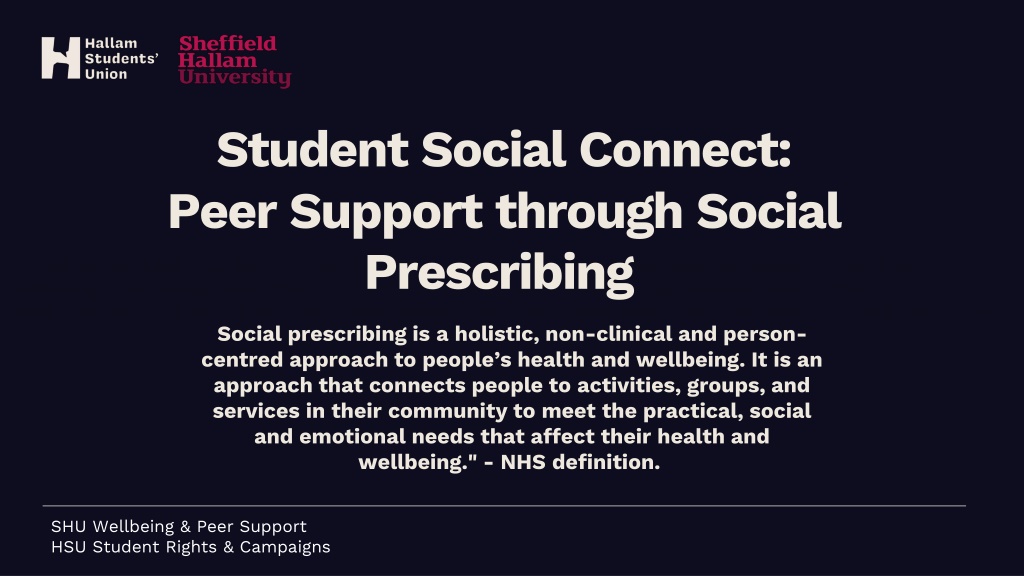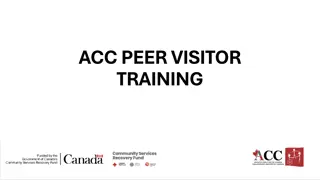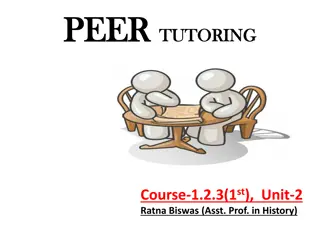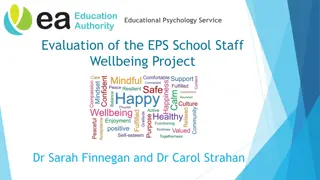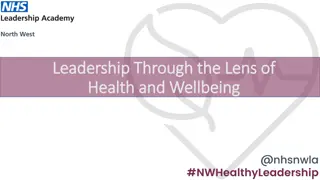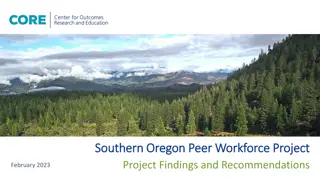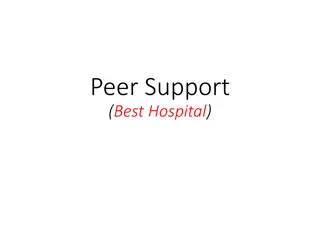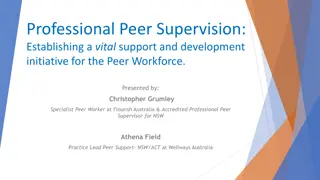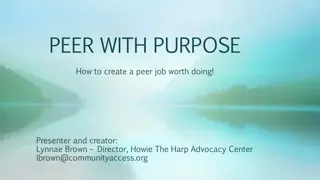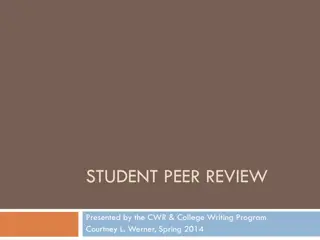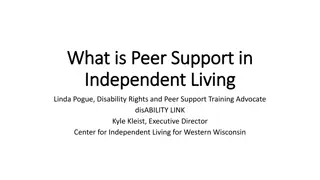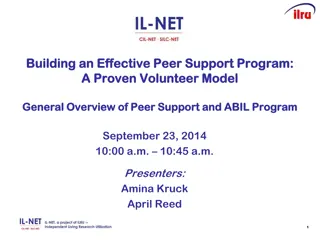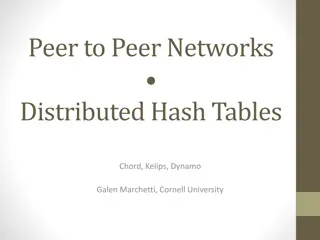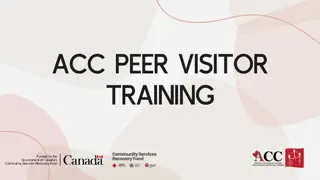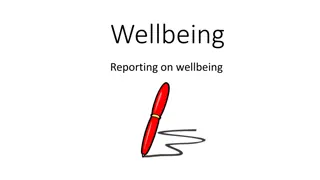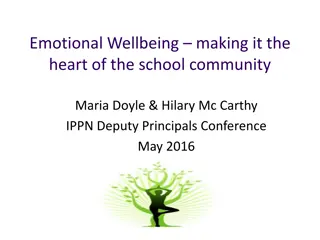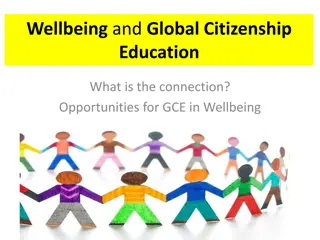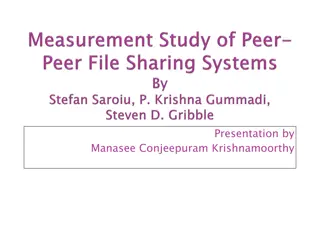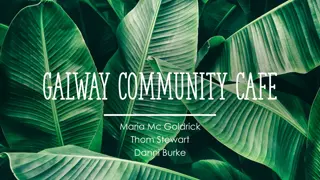Peer Support Program for Student Wellbeing Enhancement
Peer Support Program called Student.Social.Connect offers social prescribing interventions for student wellbeing, addressing issues like mental health, loneliness, and lack of support network. The program, initiated after identifying the need through a survey, involves connectors working with students to co-create tailored wellbeing plans. The pilot project successfully recruited student community leaders, provided basic training, and established a referral process. The process includes registration with Wellbeing, risk assessment, engagement evaluation, and information sharing agreement for collaborative support.
Download Presentation

Please find below an Image/Link to download the presentation.
The content on the website is provided AS IS for your information and personal use only. It may not be sold, licensed, or shared on other websites without obtaining consent from the author. Download presentation by click this link. If you encounter any issues during the download, it is possible that the publisher has removed the file from their server.
E N D
Presentation Transcript
Student Social Connect: Peer Support through Social Prescribing Social prescribing is a holistic, non-clinical and person-centred approach to people s health and wellbeing. It is an approach that connects people to activities, groups, and services in their community to meet the practical, social and emotional needs that affect their health and wellbeing." - NHS definition. Social prescribing is a holistic, non-clinical and person- centred approach to people s health and wellbeing. It is an approach that connects people to activities, groups, and services in their community to meet the practical, social and emotional needs that affect their health and wellbeing." - NHS definition. SHU Wellbeing & Peer Support HSU Student Rights & Campaigns
Context & Starting Off Evidence from the HSU Hallam How re We Doing Survey indicated a need for increased and varied wellbeing interventions for students. The survey showed the main reasons students consider dropping out of university were mental health (54%), loneliness (27%), lack of support network (19%) and struggling to make friends (17%). HSU had a pre-existing infrastructure that could be tapped into as a wellbeing resource, rather than reinventing the wheel or outsourcing a service. Sports clubs, events, GIAGs, societies, volunteering brokerage, academic opportunities, jobs. Invested in the idea of University community in practice An opportunity for meaningful peer support/student staff opportunity
Student Social Connect was born! Student Social Connect is a peer-to-peer social prescribing program The pilot involved Connectors (Student Staff) working with students to co-create wellbeing plans, ranging from activities, events, societies, lifestyle changes etc for up to 6 weeks to support them with low-risk wellbeing issues such as loneliness & low- level anxiety & depression.
The Social Connect Pilot Held over 5 months in Semester 2 of the 23/24 academic year. Recruited 3 student community leaders for the project from the university Completed some basic training, including GDPR and safeguarding Connectors signed a confidentiality agreement Created a process for referrals and ongoing support for the connectors Advertised the service to Student Wellbeing and there was also a way for student's to directly refer.
The process Received by WB in Wellbeing via CRM or email Logged and recorded on CRM Student must be registered with Wellbeing -Check referral meets criteria. Review Wellbeing info. Check for risk. -Send email to student acknowledging re ferral and arranging time to call - Into to service -Are they able to engage? -Are they safe to access the service? -Are they motivated to engage? -Info sharing agreement to share info with SU and Connector -evaluation -Book appointment with Connector on Teams calendar -Referral form completed (incl basic info about what they are interested in, brief MH details, date of initial appointment) -Referral form shared with Connector and WBC (SU) Connector makes initial contact with student connectee via Teams messaging. Confirming date, time and place of initial meeting -In person meeting on campus -Consider what connectee is interested is -Create plan with student -Connector checks in with student -Sends reminders and updates to student via Teams -Arrange in person reviews - Attends activities /groups with student -Fortnightly meetings with Connectors -Regular check in via Teams with Connectors -HSU/SHU staff available for any issues which occur -Support is reviewed at fortinghtly check ins -Connectee confirms support is ended by message on Teams -If student no longer needs/wants support, ending call to complete evaluation Initial meeting Connect or and Connect ee Ongoing Support to Connect ors 'Welco me call' complet ed Link with Connect or 6 weeks of support Screen referral Ending Support Referral
How did it go? A total of 27 students were referred 15 students were matched with a student The connectors averaged around 4 hours with each connectee Students took part in a range of activities, from social sport, volunteering, nature walks, ice skating
Does it work? SWEMWBS Short Warwick Edinburgh Mental Well-Being Scale (SWEMWBS): SWEMWBS asks the participant to respond to 7 statements relating to wellbeing: a sense of optimism, usefulness, how relaxed they are, how they deal with problems, thinking clearly, feeling close to other people and making their mind up about things. 73% of students wellbeing score improved over the trial. J, K, L and M did not meet up in person with their connector in person
Student Case Studies Student I Student I was an International PGT student, who described themselves as feeling low in mood and missing social networks from home, they wanted to meet more people in Sheffield and feel more involved in a community here. Student I decided to book onto a volunteering day at Burngreave library. Although the slots were all full upon trying to book, Hallam SU was able to use their existing volunteering coordinator contacts to get them a space. They now regularly volunteer at Burngreave library They stated in the evaluation that the presentation of activities of interest by the Connector was really helpful and having options isolated down helped them. They stated their connector was calm, approachable and made the process relaxed. They felt more sociable, less lonely and that it felt good to get a volunteering opportunity. This was our first and only self-referral student. Their SWEMWBS score went from 15 to 24.
Student Case Studies Student B Student B stated they were struggling with low mood as they were a victim of homophobic abuse on their course. They felt very isolated and were looking at changing universities. They were paired with the Connector (student staff), who upon meeting the student raised the concerns mentioned in the referral form as she felt concerned and we were able to react quickly to this and work with Report and Support, SSA and the wellbeing service to ensure all parties were up to speed and they were being adequately supported and that they were suitable for the programme. Student B and the Connector then went to a GIAG ice skating session which Student B really enjoyed and continued to attend after the scheme ended. Student B's SWEBS score increased from 17 to 25 in the pre and post eval survey. A quote provided by their connector: Thanks again for going with me, I really enjoyed it. Never had this much fun since I came to Hallam, see you around :) On the evaluation scheme Student B said, I ve got exactly what I needed from Social Connect. I feel much more connected to people now. I feel much more stable in my mental health and feels much happier in Sheffield.
What did students find helpful? Connectors - all students have been positive about their Connector commenting on them being friendly, calm, approachable. Several students have commented that they really enjoyed meeting their Connector. One comment that they were pleased the Connector was a student. Comment: the students who help are the best part. Method of contact (via Teams or face to face). Several students have commented that messaging on Teams has been helpful. One students liked being prompted on messages about what was going on. - Another student said the most useful thing was their Connector checking on her and gave her a chance to share her emotions about how she was feeling. Finding activities - 10 students have made comments about it being helpful to have someone that finds activities for them, having a list to choose from has been helpful, having a list based on interest was helpful, having activities isolated things down for him which made things easier to choose, helping them to find what was available, that their Connector has gone out of their way to find activities. One student felt their Connector found things that they wouldn t of been able to. Comment: The most useful thing was all the information about what was available and what the SU had on offer. Going to activities with their connector Not all students went to activities with their Connector. Many only had contact over Teams messaging. One student who went to with connector commented that it made him feel less alone. Without this he may not have gone. Someone else commented that having a connector there at a sports activity helped.
What did students find helpful? Mostly having somebody else to push to try new things. It s really great especially for students far away from home. I hope students take this opportunity. It s a very good initiative. He said that he d found the social connect service really helpful to meet some normal people and he feels much more connected to people now. "More confident doing things by myself. Went to badminton. Having Connector there helped."
Positive Student Job Opportunity Skills which Connectors says they have gained: speaking to different people improved communication and interpersonal skills taking leadership of situations patience emotional intelligence gained greater awareness of the issues which other people face time management and organisation skills What Connectors have said: Being a connector holds value not only in professional realms but also in personal development, fostering relationships and forging new connections that contribute to personal growth and development. Witnessing the benefit that arise for those involved in the programme is also particularly rewarding. Connector It s challenged me to get out of my comfort zone and explore activities I may never have known existed. The students I ve met on the scheme have provided me with positive feedback and appear to have genuinely gained value from the service. - Connector
Did it make a difference toyour Wellbeing? "Just getting out has helped." Overall going once to badminton he feels more at ease and ready to work through his depression. Student thinks it did, he felt/feels more sociable, and it was good to get a volunteering opportunity. He says he felt less lonely after the scheme. "Yes, it has given me more confidence to try something else" "The scheme makes me feel like I actually want to try other things. " Feels much more stable in his mental health and doesn t feel he needs any other form of support from student Wellbeing. Feels much happier in Sheffield and even though he has a stressful exam period coming up he isn t feel stressed and feels ok about the exams.
Challenges Challenges Referral Process In the pilot the process was completed by SHU in Wellbeing due to Connectees having to be registered with Wellbeing. This means that: -SU was not included in this process -Students had to be registered with wellbeing which which we felt was barrier to engagement and excluded other students the service.
Challenges Challenges 27 students referred. 12 of these referrals didn t access the service Student engagement From feedback from Connectors we know that many of the students accessing the service have been difficult to engage; often don t reply to messages, don t want to attend activities, cancel meets ups and needs lots of promoting to confirm attendance. Several issues raised on pilot around safety of students: -One student telling their connector they had a large amount of prescribed tablets and indicating they may take an overdose -another student telling connector about being bullied and victim of homophobia/racism -Inappropriate student referred to the scheme as a serious mental health concern was later flagged Safeguarding concerns
Student Social Connect 2.0 Recommendations: Use a form type on Microsoft Teams which will help ensure suitable students access the scheme. Questions around mental health, desire to engage and reasons for engaging will help filter suitable students through to the registration form, while also signposting and redirecting students to suitable information/support should they indicate they aren t suitable for the scheme. Students should be given 6 sessions over 4-6 weeks, rather than a 6-week timeslot on the scheme, following a more traditional social prescribing/therapy/support schedule. Introduction of using Shifts on Teams Introduce UCLA3 and MYCaW as evaluation methods as well as ONS4 and remove SWEMBWS. Hired four student social connectors for next academic year, hoping to reach 200 students
